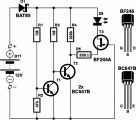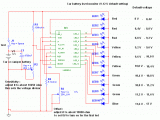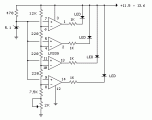Car battery related schematics
 Going camping nowadays involves taking lots of electronic equipment whether for day to day running or for fun and entertainment. Most of the time a charged lead acid battery and a power inverter would be used to ensure a smoothly organized holiday where ideally the missus and the children cheerfully use their electric and electronic gear! With rechargeable lead-acid batteries it’s invariably useful - if not essential - to determine whether the power source you’re hauling along on your travels is losing capacity and needs to be topped up. The same circuit would also come in handy when going on a car or motorbike trip as it can check the status of a 12 V (car) or a 6 V (motorcycle) battery....
[read more]
Going camping nowadays involves taking lots of electronic equipment whether for day to day running or for fun and entertainment. Most of the time a charged lead acid battery and a power inverter would be used to ensure a smoothly organized holiday where ideally the missus and the children cheerfully use their electric and electronic gear! With rechargeable lead-acid batteries it’s invariably useful - if not essential - to determine whether the power source you’re hauling along on your travels is losing capacity and needs to be topped up. The same circuit would also come in handy when going on a car or motorbike trip as it can check the status of a 12 V (car) or a 6 V (motorcycle) battery....
[read more]
 Connecting this circuit to the battery of your vehicle, you will always know at a glance the approximate voltage available. An indication of battery voltage is useful to the motorist for monitoring the battery's capacity to deliver current, and as a check on the efficiency of the dynamo or alternator. Threshold voltages of the Leds are set by means of two Zener Diodes (D6 & D10) plus two further Diodes wired in series (D4, D5 and D8, D9 respectively) adding a step of about 1.3V to the nominal Zener voltage....
[read more]
Connecting this circuit to the battery of your vehicle, you will always know at a glance the approximate voltage available. An indication of battery voltage is useful to the motorist for monitoring the battery's capacity to deliver current, and as a check on the efficiency of the dynamo or alternator. Threshold voltages of the Leds are set by means of two Zener Diodes (D6 & D10) plus two further Diodes wired in series (D4, D5 and D8, D9 respectively) adding a step of about 1.3V to the nominal Zener voltage....
[read more]
 This i-TRIXX circuit can prevent a whole lot of trouble for those of you who go on holiday in a caravan. It would be a significant damper on your holiday spirit when you are ready to leave the camping and discover that you have used your battery too much and that you are now unable to start the car. This annoyance can be avoided if you were warned early enough by an illuminated LED when the charge in the battery threatens to become too low....
[read more]
This i-TRIXX circuit can prevent a whole lot of trouble for those of you who go on holiday in a caravan. It would be a significant damper on your holiday spirit when you are ready to leave the camping and discover that you have used your battery too much and that you are now unable to start the car. This annoyance can be avoided if you were warned early enough by an illuminated LED when the charge in the battery threatens to become too low....
[read more]
 This circuit uses the popular and easy to find LM3914 IC. This IC is very simple to drive, needs no voltage regulators (it has a built in voltage regulator) and can be powered from almost every source....
[read more]
This circuit uses the popular and easy to find LM3914 IC. This IC is very simple to drive, needs no voltage regulators (it has a built in voltage regulator) and can be powered from almost every source....
[read more]
 In the circuit, a quad voltage comparator (LM339) is used as a simple bar graph meter to indicate the charge condition of a 12 volt, lead acid battery. A 5 volt reference voltage is connected to each of the (+) inputs of the four comparators and the (-) inputs are connected to successive points along a voltage divider. The LEDs will illuminate when the voltage at the negative (-) input exceeds the reference voltage....
[read more]
In the circuit, a quad voltage comparator (LM339) is used as a simple bar graph meter to indicate the charge condition of a 12 volt, lead acid battery. A 5 volt reference voltage is connected to each of the (+) inputs of the four comparators and the (-) inputs are connected to successive points along a voltage divider. The LEDs will illuminate when the voltage at the negative (-) input exceeds the reference voltage....
[read more]